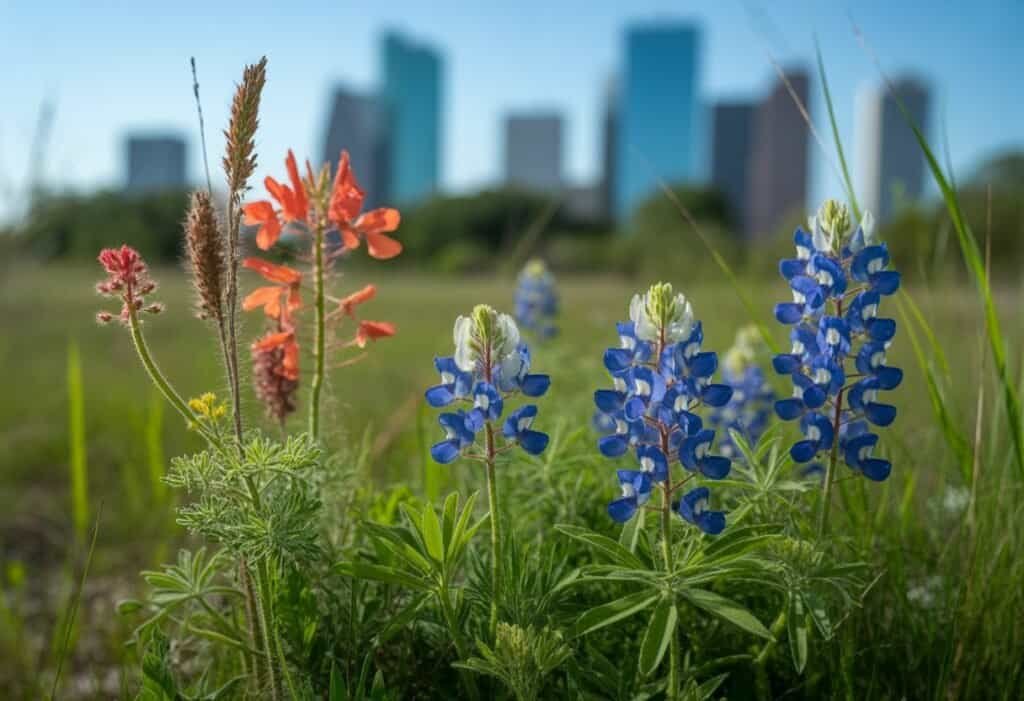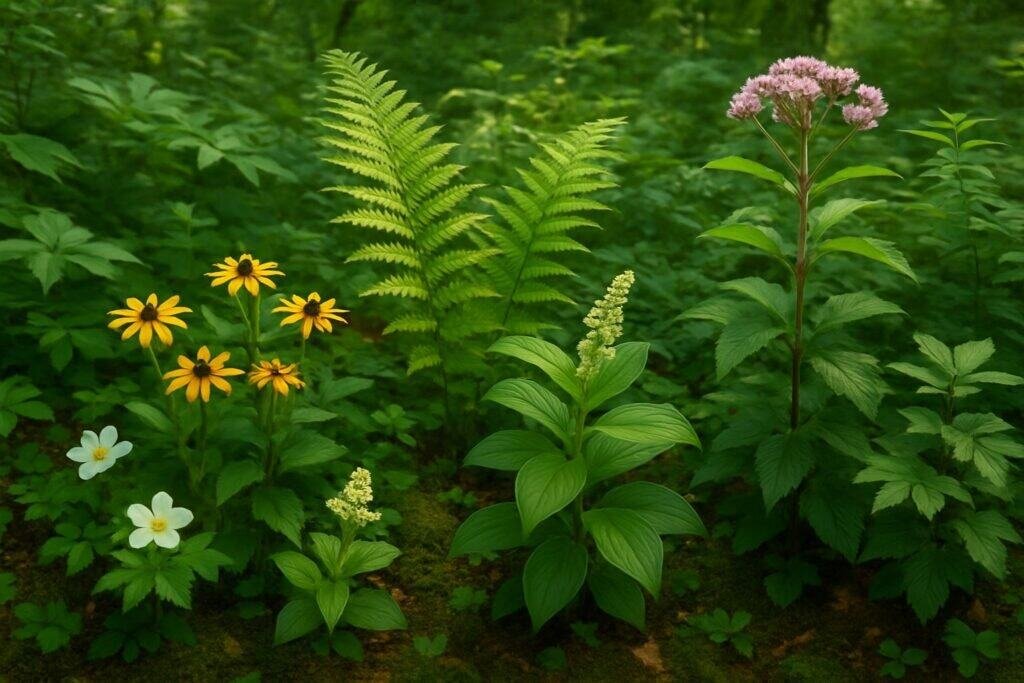Native plants in Houston offer a perfect solution for creating beautiful, low-maintenance gardens that thrive in our unique climate. These plants have evolved over thousands of years to adapt to Houston’s hot summers, unpredictable rainfall, and clay soils.
Choosing native plants for your Houston garden saves water, reduces maintenance needs, and creates crucial habitat for local wildlife including birds, butterflies, and beneficial insects.
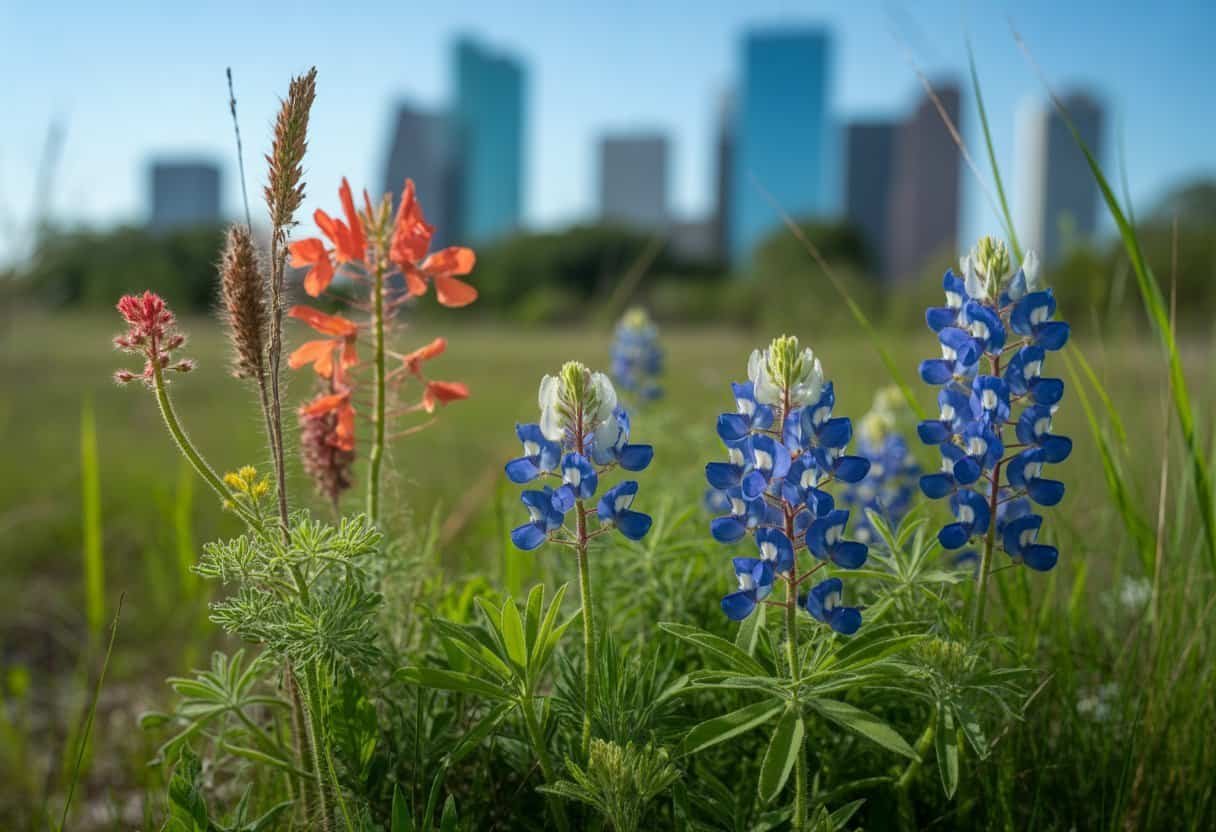
From the vibrant purple coneflower to the majestic live oak, Houston’s native flora offers options for every garden style and size. Native plants develop deeper root systems that help manage stormwater runoff and prevent erosion during heavy Gulf Coast rains.
They also need fewer fertilizers and pesticides since they’ve already adapted to local conditions and pests.
Key Takeaways
- Native Houston plants need less water, fertilizer, and maintenance while thriving in local soil and climate conditions.
- Local wildlife depends on native plants for food and habitat, making your garden an important part of the ecosystem.
- Adding native plants to your Houston landscape helps preserve biodiversity and creates a sense of regional character and beauty.
What Are Native Plants in Houston?
Native plants in Houston are species that evolved and adapted to the local climate and soil conditions over thousands of years. These plants thrive naturally in the Gulf Coast region without needing excessive care or resources.
Defining Native and Adapted Plants
Native plants existed in the Houston region before European settlement. They evolved alongside local wildlife, creating interdependent relationships.
These plants include trees like the Live Oak and Southern Magnolia, shrubs such as American Beautyberry, and wildflowers like Black-eyed Susan. Adapted plants, while not native, also thrive in Houston’s climate with minimal care.
These plants originate from regions with similar growing conditions. True natives provide the most ecological benefits because they’ve developed specific traits to handle Houston’s heavy clay soils, humid subtropical climate, and periodic flooding.
Many garden centers now label plants as “native” to help gardeners make informed choices for their Houston gardens.
Why Native Plants Matter in the Houston Region
Native plants in Houston reduce maintenance needs. They need less water, fertilizer, and pesticides than non-native species.
These plants support local wildlife in important ways. Native flowers provide nectar for pollinators like butterflies and bees.
Native trees and shrubs offer nesting sites and food for birds. Houston’s frequent flooding presents challenges for many gardens, but native plants have adapted to this cycle.
Deeper root systems help manage stormwater and prevent erosion. Native plants also tolerate Houston’s hot summers and occasional freezes better than exotic species.
Unique Attributes of Houston’s Native Flora
Houston’s native plants display remarkable adaptations to local conditions. Many feature waxy leaves that reduce water loss during hot summers.
Others develop extensive root systems to find water during dry periods. Houston sits at the intersection of coastal prairies, piney woods, and post oak savannah ecosystems.
This location creates a rich palette of native plants for gardens.
Notable Houston Natives:
- Gulf Coast Muhly Grass: Pink cloud-like blooms in fall
- Texas Lantana: Drought-tolerant with vibrant orange-yellow flowers
- Bald Cypress: Flood-tolerant tree with distinctive “knees”
- Coral Honeysuckle: Red tubular flowers that attract hummingbirds
These plants connect modern landscapes to the region’s natural heritage and provide practical benefits for homeowners.
Ecological Benefits of Houston Native Plants
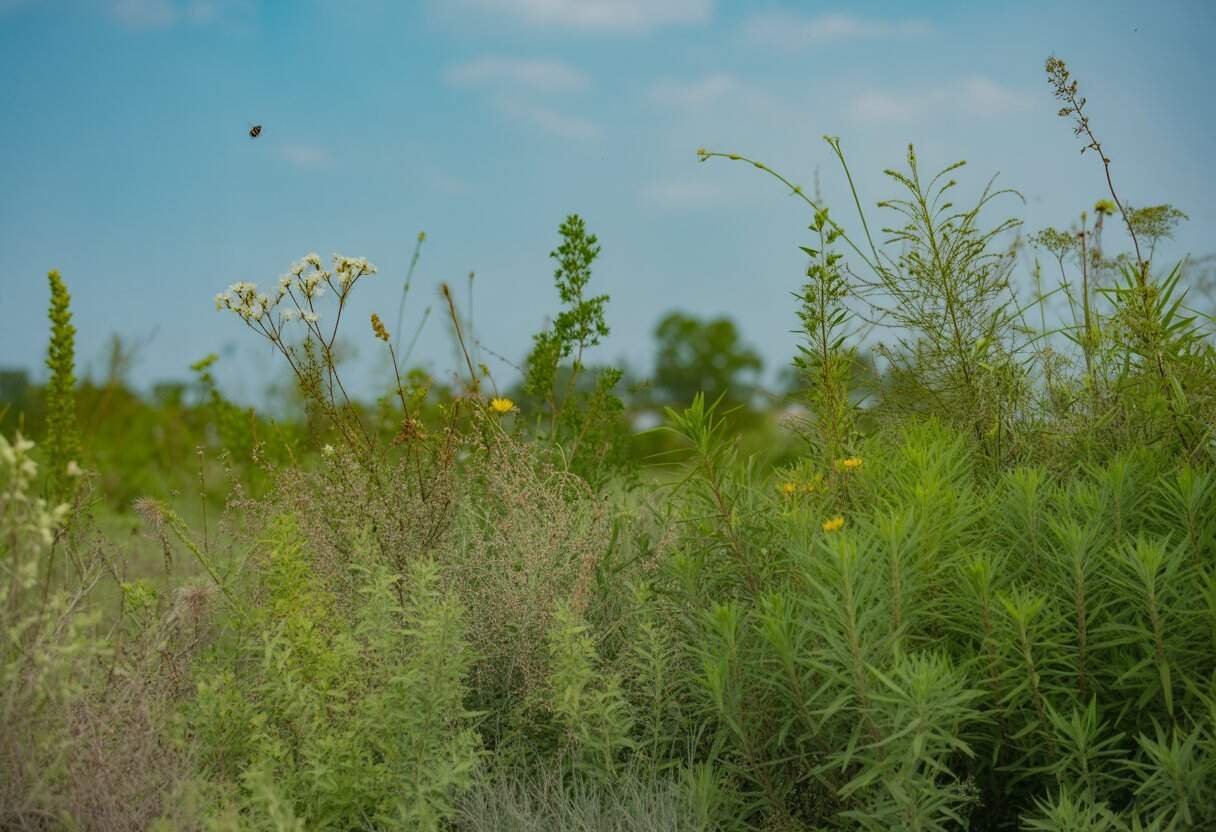
Native plants in Houston provide essential ecological services that support local ecosystems. These plants evolved alongside local wildlife and environmental conditions, making them uniquely suited to benefit the region’s natural systems.
Attracting Pollinators and Wildlife
Native plants serve as crucial habitat for local wildlife. Houston natives like American Beautyberry, Gulf Coast Muhly, and Texas Lantana attract butterflies such as Gulf Fritillaries and Monarchs.
These plants provide nectar for adult butterflies and food for their caterpillars. Hummingbirds visit native Turk’s Cap, Coral Honeysuckle, and Scarlet Sage.
These birds are drawn to the tubular, red flowers that produce abundant nectar. Native plants support diverse pollinators including:
- Native bees
- Butterflies
- Moths
- Beetles
- Hummingbirds
The Native Plant Society of Texas, Houston Chapter, offers guidance on plant selection for wildlife gardens. Their resources help gardeners create spaces that support local fauna year-round.
Improving Soil and Water Conservation
Houston’s clay soils and heavy rainfall present unique challenges that native plants naturally address. Deep-rooted natives like Little Bluestem and Switchgrass help prevent erosion during heavy storms.
Native plants usually need less irrigation once established. This water conservation is important in Houston’s hot summers and during drought periods.
Their extensive root systems improve soil structure by:
- Creating pathways for water infiltration
- Reducing runoff and flooding
- Adding organic matter as roots die back
- Supporting beneficial soil microorganisms
Organizations like Bayou Land Conservancy support the use of natives for watershed protection. Their demonstration gardens show how these plants help manage Houston’s stormwater naturally.
Enhancing Biodiversity in Urban Landscapes
Native plants create resilient urban ecosystems in Houston’s expanding metropolitan area. They provide genetic diversity that helps local ecosystems adapt to changing conditions and resist disease.
Research shows neighborhoods with native plantings support more bird and insect species than those with mostly non-native landscaping. This biodiversity strengthens the ecological web.
Native plant communities create microhabitats that support:
- Beneficial insects that control garden pests
- Small mammals like opossums that consume ticks
- Birds that disperse seeds and control insect populations
The Houston Arboretum & Nature Center demonstrates how natives can transform urban spaces into biodiversity hotspots. Their restoration projects replace invasive species with native plant communities that support entire ecosystems.
Selecting Native Plants for Houston Gardens
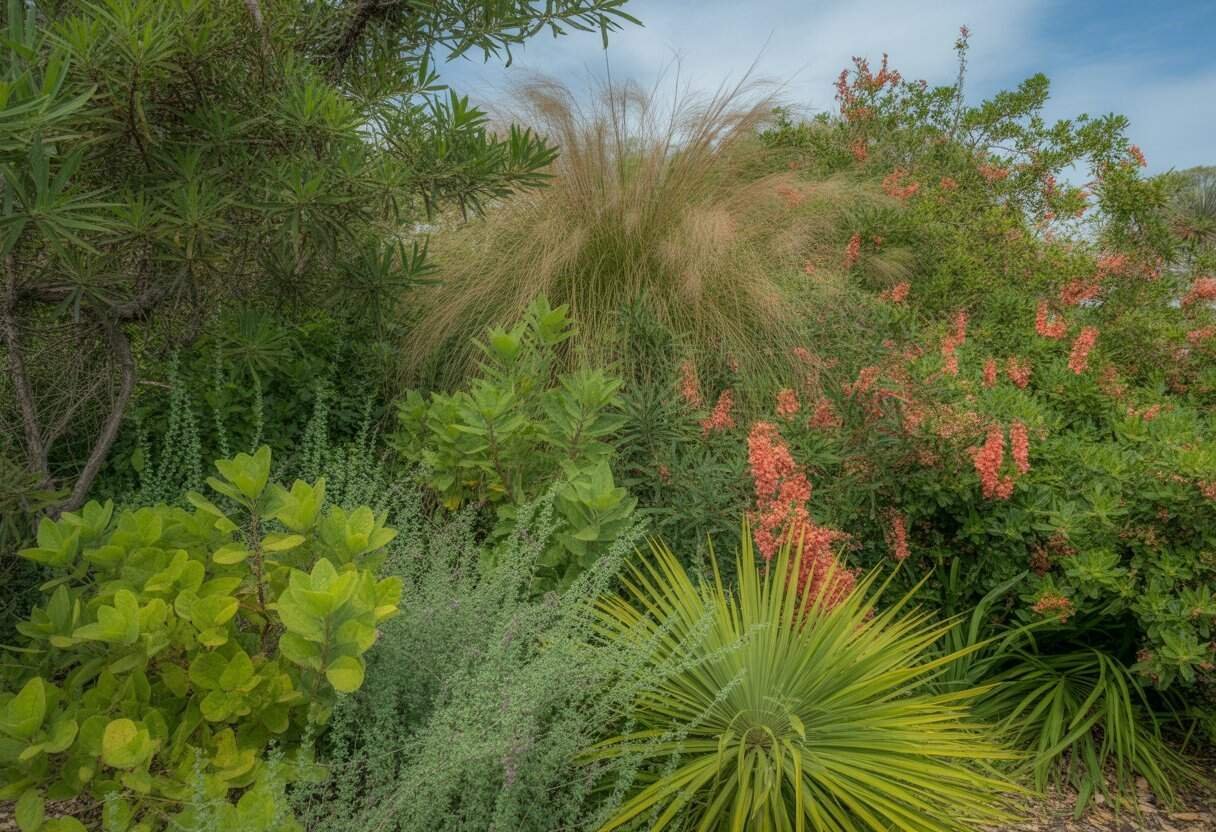
Native plants thrive in Houston’s climate with minimal care while supporting local wildlife. They adapt to the region’s hot summers, unpredictable rainfall, and occasional freezes.
Choosing Plants for Full Sun Locations
Full sun areas in Houston gardens need plants that can withstand intense summer heat. Black-eyed Susans (Rudbeckia hirta) offer bright yellow blooms from spring through fall and attract butterflies and birds.
Gulf Coast muhly grass (Muhlenbergia capillaris) creates pink-purple plumes in autumn. This grass reaches about 3 feet tall and tolerates both wet and dry conditions.
Texas sage (Leucophyllum frutescens) produces lavender flowers after rain showers. Its silver-gray foliage adds texture to gardens year-round.
Lantana (Lantana urticoides) provides color from spring until frost. This low-maintenance plant attracts pollinators and comes in various colors.
Best Full Sun Plants for Houston:
- Butterfly weed (Asclepias tuberosa)
- Prairie verbena (Glandularia bipinnatifida)
- Mexican hat (Ratibida columnifera)
- Gregg’s mistflower (Conoclinium greggii)
Drought Tolerant Varieties for Houston
Drought-resistant plants help Houston gardens survive dry spells without excessive watering. Yaupon holly (Ilex vomitoria) grows well in various conditions and produces red berries that birds love.
Turk’s cap (Malvaviscus arboreus) features unique red flowers that bloom even in shade. This adaptable plant attracts hummingbirds throughout summer.
Coralberry (Symphoricarpos orbiculatus) offers pink berries that persist through winter. It grows well in both sun and shade.
Texas sage and lantana also excel during drought periods. These plants develop deep root systems that access groundwater during dry times.
Water-Wise Plant Options:
- Skeletonleaf goldeneye (Viguiera stenoloba)
- Rock rose (Pavonia lasiopetala)
- Texas kidneywood (Eysenhardtia texana)
- Fall aster (Symphyotrichum oblongifolium)
Evergreen Shrubs for Year-Round Interest
Evergreen shrubs maintain Houston gardens’ structure and color during winter months. American beautyberry (Callicarpa americana) keeps its form year-round with purple berries in fall.
Wax myrtle (Morella cerifera) grows quickly and creates privacy screens. Its aromatic leaves repel insects naturally, and birds enjoy its berries.
Dwarf yaupon holly forms excellent borders and hedges. This compact shrub withstands pruning well and stays green throughout winter.
Cherry laurel (Prunus caroliniana) makes a good background plant. It grows into a small tree or large shrub with glossy leaves that complement flowering plants.
Recommended Evergreen Choices:
- Texas mountain laurel (Sophora secundiflora)
- Southern wax myrtle (Morella cerifera)
- Yaupon holly varieties
- American beautyberry (semi-evergreen)
Popular Native Grasses and Wildflowers
Houston’s landscape comes alive with native grasses and wildflowers that thrive in the local climate. These plants need less water and maintenance than non-native species and add beautiful textures and colors to gardens.
Notable Native Grasses
Gulf Coast Muhly (Muhlenbergia capillaris) stands out as one of Houston’s most beloved native grasses. In fall, it produces pink-purple seed heads that catch the evening light, creating a misty, cloud-like appearance.
This drought-tolerant grass grows 2-3 feet tall and works well in borders or mass plantings. Little Bluestem is another excellent choice for Houston gardens.
Its blue-green summer foliage turns reddish-orange in fall and winter. This grass provides valuable habitat for birds and small mammals.
Eastern Gamagrass thrives in Houston’s clay soils and can handle both wet and dry conditions. It grows in attractive clumps and adds vertical interest to garden designs.
Iconic Wildflower Species
Black-eyed Susan (Rudbeckia hirta) brightens Houston gardens with golden-yellow petals surrounding dark centers. These flowers bloom from early summer through fall and attract butterflies and beneficial insects.
They self-seed readily, creating naturalized patches over time. Purple Coneflower (Echinacea purpurea) performs well in Houston’s climate.
Its purple petals and raised central cone make it instantly recognizable. This plant serves as an important nectar source for pollinators.
Indian Blanket features red petals with yellow tips, resembling traditional Native American blankets. This drought-tolerant wildflower blooms in spring and early summer.
Texas Lantana displays clusters of orange, yellow, and red flowers that attract many butterfly species. It handles Houston’s heat with ease and blooms from spring until the first frost.
Standout Native Shrubs and Trees of Houston
Houston’s climate supports a variety of beautiful native plants that thrive in local conditions. These native shrubs and trees provide habitat for local wildlife while needing less maintenance than non-native species.
Favorite Native Shrubs
Yaupon Holly (Ilex vomitoria) stands out as one of Houston’s most versatile native shrubs. This evergreen can be pruned into formal hedges or allowed to grow naturally into a small tree.
It produces bright red berries that birds love during winter months. American Beautyberry (Callicarpa americana) offers visual interest with clusters of vibrant purple berries in fall.
The berries persist after the leaves drop and provide food for birds. Wax Myrtle (Morella cerifera, formerly Myrica cerifera) serves as an excellent screening plant with aromatic, olive-green foliage.
Also known as Southern Wax Myrtle, this adaptable shrub tolerates both wet and dry conditions. It grows quickly to 10-15 feet.
These native shrubs attract beneficial insects and provide nesting sites for birds.
Native Trees for Urban and Residential Areas
Live Oak trees dominate Houston’s landscape with sprawling branches and impressive canopies. These trees can live for centuries and provide extensive shade.
Cedar Elm thrives in Houston’s clay soils and offers yellow fall color. This medium-sized tree tolerates urban conditions and provides habitat for wildlife.
Mexican Plum produces fragrant white flowers in early spring before leafing out. This small tree rarely exceeds 20 feet, making it suitable for smaller yards and spaces near power lines.
River Birch features attractive peeling bark and adapts well to Houston’s periodic flooding. Its multi-trunk form creates visual interest year-round while providing shade and wildlife habitat.
Colorful Flowering Native Plants
Houston gardens can burst with color when planted with native flowering species. These plants thrive in local conditions and support wildlife.
Perennials and Seasonal Favorites
Texas Lantana (Lantana urens) offers clusters of bright orange, yellow, or pink flowers that bloom from spring until the first frost. This drought-tolerant perennial grows 2-4 feet tall and spreads easily in sunny spots.
Autumn Sage (Salvia greggii) produces tubular flowers in red, pink, or purple nearly year-round in Houston’s climate. This woody perennial reaches about 3 feet tall and performs best with occasional pruning.
Black-eyed Susan (Rudbeckia hirta) delivers cheerful yellow blooms with dark centers from June through October. This perennial self-seeds readily, creating natural drifts of color in sunny areas.
Turk’s Cap (Malvaviscus arboreus) features unique red hibiscus-like flowers that never fully open, resembling a Turkish turban. It grows 3-5 feet tall and tolerates a variety of soil conditions.
Best Plants for Attracting Butterflies and Hummingbirds
Autumn Sage and Texas Lantana attract many butterflies in Houston gardens. Their tubular flowers provide abundant nectar for butterflies and hummingbirds throughout the growing season.
Butterfly Favorites:
- Texas Lantana
- Black-eyed Susan
- Autumn Sage
- Gulf Coast Penstemon
Turk’s Cap (Malvaviscus arboreus) excels at attracting hummingbirds with its bright red flowers. The curved petals perfectly fit hummingbird beaks.
Plant these species in groups rather than individually. Clusters of flowering plants create more visual impact and provide more substantial food sources for pollinators.
Native Flowering Plants for Shade
Many Houston gardeners struggle with shady spots, but several native flowering plants thrive with limited sun. Turk’s Cap performs well in dappled shade, producing its red flowers even without direct sunlight.
American Beautyberry offers subtle spring flowers followed by purple berries in fall. This shade-tolerant shrub grows 3-5 feet tall and provides food for birds.
Columbine (Aquilegia canadensis) displays delicate red and yellow blooms in spring. This woodland native prefers morning sun with afternoon shade and moist, well-drained soil.
For ground cover in shady areas, try White Avens (Geum canadense). Its small white flowers appear in spring, and its textured foliage adds interest throughout the growing season.
Design Tips for a Thriving Native Plant Garden
Creating a successful native plant garden requires thoughtful planning and arrangement. The right design enhances beauty and ecological function while making maintenance easier.
Incorporating Layers and Structure
Native plant gardens work best when organized in layers, similar to natural ecosystems. Start with tall trees like Texas redbud or Mexican plum as the upper canopy.
Add medium-sized shrubs such as American beautyberry or yaupon holly for the middle layer. Fill the ground layer with native grasses like Gulf muhly and Little bluestem.
Include groundcovers such as frogfruit or horsefoot violet to complete the structure. Group plants with similar water needs together for efficient maintenance.
Place drought-resistant plants like blackfoot daisy and Texas sage in sunny spots. Consider garden pathways using local stone or mulch to create access points without disturbing plant communities.
These paths also provide visual structure to the garden design.
Seasonal Color and Texture Planning
Houston gardens can showcase color year-round with proper planning. Spring blooms come from Texas bluebonnets and pink evening primrose.
Summer brings vibrant coneflowers and black-eyed Susans. Fall displays feature Gulf muhly grass with pink plumes and the yellows of Maximilian sunflower.
Winter interest comes from evergreens like wax myrtle and the red berries of possumhaw holly. Mix different leaf shapes and textures for visual interest.
Pair the fine texture of grasses with bold-leaved plants like turk’s cap or coralberry. Stagger bloom times by selecting early, mid, and late-season flowering plants for each season.
This approach ensures continuous food for pollinators and year-round visual appeal. Include at least 30% evergreen plants to maintain structure during winter months.
Resources and Organizations Supporting Native Plants
Houston has a vibrant community of organizations, nurseries, and regional connections dedicated to native plants. These resources provide education, plants, and volunteer opportunities for all gardeners.
Local Organizations and Volunteer Opportunities
The Native Plant Society of Texas – Houston Chapter hosts monthly meetings and regular plant swaps. They organize educational workshops and native plant rescues from development sites.
Houston Audubon Society maintains several sanctuaries with native plant gardens. They offer volunteer days where people can help maintain these habitats and learn about native plants.
The Nature Conservancy in Texas works on larger conservation projects and sometimes hosts native plant workshops around Houston. Urban Harvest coordinates community gardens throughout Houston and provides classes on native plant gardening.
Their annual fruit tree sale often includes native options. Texas Master Naturalists (Gulf Coast Chapter) offers training programs and service projects focused on native habitat restoration.
Members volunteer over 200,000 hours annually throughout Texas.
Recommended Houston Garden Centers and Nurseries
Buchanan’s Native Plants specializes in Texas natives. Their knowledgeable staff can help match plants to specific yard conditions.
Joshua’s Native Plants offers a wide selection of native plants and organic gardening supplies. They provide free gardening advice for customers.
The Arbor Gate in Tomball carries many native options alongside ornamentals. They host regular workshops on native plant care.
Houston Garden Centers with native plant sections:
- Cornelius Nursery
- RCW Nurseries
- Maas Nursery
Many nurseries now label native plants with special tags to help customers identify them. Some offer discounts during Texas Native Plant Week in October.
Regional Connections: Houston, San Antonio, and Beyond
The Lady Bird Johnson Wildflower Center in Austin serves as Texas’s premier native plant resource. Their website offers a searchable database of plants native to Houston’s region.
San Antonio Botanical Garden features a Texas Native Trail with plants from different Texas ecosystems. Their plant sales offer native varieties adapted to the region.
The Coastal Prairie Partnership connects Houston and San Antonio conservation efforts. They coordinate regional initiatives to restore native grasslands.
Annual events like the Wildscapes Workshop rotate between Houston, San Antonio, and other Texas cities. These gatherings allow gardeners to exchange regional knowledge.
The Texas A&M AgriLife Extension Service provides science-based information about native plants through local county offices in both Houston and San Antonio areas.
Frequently Asked Questions
Houston gardeners often have specific questions about native plants. These answers provide practical guidance on selecting, finding, and growing native species suited to Houston’s climate.
What are the best native plants to use for landscaping in Houston?
Gulf Coast Muhly grass offers pink plumes in fall and thrives in Houston’s climate. It reaches about 3 feet tall and requires minimal maintenance once established.
Texas Sage (Cenizo) provides purple blooms during humid periods and withstands drought. Its silvery foliage adds year-round interest to landscapes.
American Beautyberry produces purple berries in fall that attract birds while tolerating partial shade. This shrub grows well in various Houston soil types.
Turk’s Cap thrives in shady areas where many plants struggle. Its red flowers attract hummingbirds and butterflies throughout summer and fall.
Where can one purchase native plants wholesale in Houston?
Buchanan’s Native Plants offers wholesale options for contractors and landscape professionals with advance notice. Their inventory includes many Houston-native species.
Joshua’s Native Plants provides wholesale purchasing for larger projects. They specialize in plants adapted to the Gulf Coast region.
The Native Plant Society of Texas Houston Chapter hosts annual plant sales where bulk purchases can often be arranged. These sales typically occur in spring and fall.
How can I obtain free native plants in Houston for my garden?
The Houston Parks Department occasionally hosts plant swaps where gardeners exchange native plants. Check their website for upcoming events.
Local gardening groups on social media often have members willing to share plant divisions or seedlings. Join Houston-area native plant groups to connect.
The Bayou Preservation Association sometimes distributes free native plants during educational events. Their programs focus on plants that help with erosion control.
Which native Houston plants are most suitable for outdoor pots?
Scarlet Sage adapts well to container life and produces red blooms that attract hummingbirds. It grows 2-3 feet tall in pots with adequate drainage.
Gulf Coast Penstemon thrives in containers and offers purple-pink flowers in spring. It tolerates Houston’s heat and humidity with appropriate watering.
Texas Lantana works well in pots with its spreading habit and orange-yellow flowers. It attracts butterflies and requires minimal care beyond occasional watering.
What flowers that are native to Texas can I incorporate into my Houston landscape?
Black-eyed Susan produces yellow blooms from early summer through fall. These drought-tolerant flowers thrive in Houston’s full sun.
Texas Bluebonnet, the state flower, creates blue displays in spring. Plant seeds in fall for best results in well-drained areas.
Purple Coneflower offers pink-purple blooms that attract pollinators. This perennial establishes deep roots to survive Houston’s hot summers.
Winecup creates a carpet of magenta cup-shaped flowers in spring. Its low-growing habit makes it excellent for borders or as a ground cover in sunny spots.
Are there any drawbacks to using native plants in Houston-area gardens?
Some native plants can spread aggressively in optimal conditions. Inland Sea Oats, for example, may need containment to prevent unwanted spreading.
Certain natives may look less manicured than conventional landscape plants. If you prefer a formal garden, you might need to prune them regularly.
A few native species attract wildlife that some homeowners consider nuisances. Beautyberry, for instance, attracts birds that may leave droppings on nearby surfaces.
Native plants sometimes need more attention during their first year. You often need to water them consistently until they become established.

